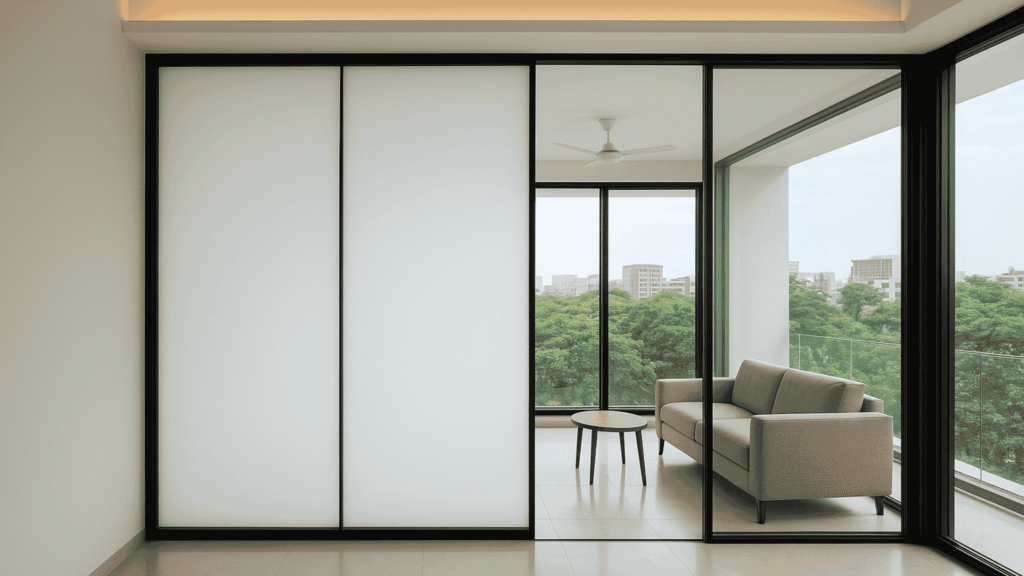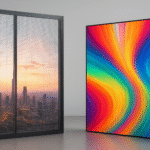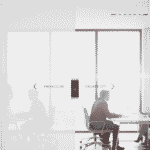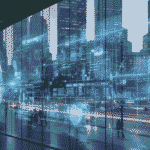In recent years, interior design has undergone a massive transformation. From traditional partitions to minimalist open layouts, the way we design and experience spaces has shifted dramatically. One innovation that is leading this change is switchable glass. Known for its ability to switch between transparency and opacity with a simple command, switchable glass has become an essential element for modern interiors across residential, commercial, and hospitality sectors.
For architects, designers, and homeowners alike, the use of switchable glass introduces both practicality and elegance. Companies like Glasstronn have been pioneering advanced glass solutions that seamlessly merge functionality with style. With its expertise in delivering cutting-edge materials, Glasstronn is helping spaces across India transform into smart, dynamic, and visually stunning interiors.
What is Switchable Glass?
Switchable glass, also known as privacy glass, is a special type of glass that changes its transparency when an electrical current is applied. When powered on, the glass turns clear; when powered off, it becomes frosted or opaque. This is made possible through PDLC (Polymer Dispersed Liquid Crystal) technology.
It combines modern aesthetics with practical benefits, making it one of the most versatile interior solutions today.
Why Switchable Glass is Popular in Modern Interiors
1. Privacy on Demand
Switchable glass offers instant privacy without the need for blinds, curtains, or bulky partitions. This makes it ideal for offices, bathrooms, and bedrooms where both openness and privacy are valued.
2. Maximizing Natural Light
Unlike opaque walls, switchable glass allows natural light to flow through when transparent, creating bright and inviting interiors.
3. Energy Efficiency
Switchable glass reduces the need for artificial lighting and helps in temperature regulation, contributing to lower energy costs.
4. Hygienic and Low Maintenance
With no need for dust-collecting blinds or curtains, it ensures a cleaner, low-maintenance interior environment.
5. Enhanced Aesthetics
Its sleek, futuristic look blends perfectly with minimalist and contemporary design themes.
Applications of Switchable Glass in Interiors
Switchable glass isn’t just a high-tech novelty—it has practical uses across multiple environments.
1. Office Spaces
- Transparent during open collaboration hours.
- Frosted for confidential meetings.
- Creates a balance between openness and privacy.
2. Residential Homes
- Bedroom partitions that turn private instantly.
- Bathroom doors or windows that provide privacy on demand.
- Skylights and balconies that control sunlight and heat.
3. Hospitality Sector
- Hotel rooms offer privacy with elegance.
- Conference rooms in luxury hotels.
- Decorative partitions in restaurants and lounges.
4. Healthcare Spaces
- Hospital rooms that provide patient privacy while maintaining natural light.
- Doctor consultation cabins for confidentiality.
5. Retail Stores
- Shopfronts that switch between transparent and frosted for promotions.
- Dynamic displays that elevate customer engagement.
How Switchable Glass Enhances Interior Design
Creates Flexible Spaces
Switchable glass allows one space to serve multiple functions. A living room can become a private guest room in seconds, or an office cabin can transform into an open space when needed.
Supports Minimalist Design
Modern interiors emphasize simplicity and elegance. Switchable glass eliminates the need for additional elements like curtains, ensuring a clean aesthetic.
Improves Employee Productivity
In offices, employees benefit from natural light and openness, while privacy is available whenever necessary, boosting focus and productivity.
Adds a Luxurious Touch
Switchable glass is often associated with high-end, premium interiors, making it a statement piece for homeowners and businesses alike.
Switchable Glass vs. Traditional Partitions
| Feature | Traditional Partitions | Switchable Glass |
| Privacy | Fixed, non-adjustable | Instant, on-demand |
| Natural Light | Blocks light | Allows light flow |
| Aesthetics | Basic, static | Sleek, modern, dynamic |
| Maintenance | Requires repainting or cleaning blinds | Low-maintenance |
| Flexibility | Permanent structure | Multi-functional |
This comparison highlights why modern designers increasingly choose switchable glass.
Things to Consider Before Installing Switchable Glass
To maximize its benefits, here are some factors to keep in mind:
- Purpose of Installation – Define whether you need it for privacy, aesthetics, or both.
- Type of Space – Different areas (offices, homes, hospitals) require different levels of opacity and durability.
- Power Source – Switchable glass requires a reliable electrical connection for functionality.
- Customization Options – Size, thickness, and framing can be customized.
- Budget – While switchable glass is an investment, its long-term benefits outweigh the initial cost.
Contribution to Sustainability
Switchable glass supports sustainable design by:
- Reducing the need for artificial lighting.
- Helping with temperature control, thereby lowering HVAC usage.
- Eliminating the need for non-biodegradable blinds or curtains.
For organizations aiming for green building certifications, it plays a significant role in aligning with sustainability goals.
How to Incorporate Switchable Glass Creatively
- Sliding Doors: Perfect for homes and offices, offering flexibility without consuming extra space.
- Windows: Provide sunlight while ensuring privacy when needed.
- Partitions: Stylish alternatives to drywall, adaptable to changing layouts.
- Projection Surfaces: When opaque, the glass can even serve as a screen for presentations.
Why Work with Experts Matters
The performance of switchable glass depends on quality manufacturing, installation, and after-sales support. Partnering with the best switchable glass company in India ensures not only the right product but also technical guidance, durability, and seamless integration into your interiors.
Future of Switchable Glass in Interior Design
The demand for smart, flexible, and sustainable interiors will only grow. Future advancements may include:
- Voice-controlled or app-based glass operations.
- Integration with smart home systems.
- Enhanced durability for outdoor use.
- Color-tinted switchable glass for more design variety.
Switchable glass is set to become a staple in homes and offices, not just a luxury.
Conclusion
Switchable glass is more than just a design feature—it’s a versatile solution that redefines how we experience modern interiors. With its ability to blend privacy, elegance, and functionality, it empowers designers, homeowners, and businesses to create smarter spaces.
By partnering with innovators like Glasstronn, projects can achieve both cutting-edge design and practical functionality. With its expertise and commitment to excellence, Glasstronn ensures that every installation not only meets expectations but also sets new benchmarks in modern interior design.
Switchable glass is here to stay, and for those looking to create future-ready interiors, it offers the perfect combination of technology, style, and sustainability.





